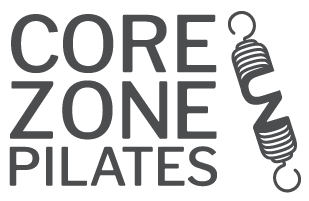FAQ
What can Pilates do for me?
- Significantly strengthen your core (abdominal muscles)
- Build long, lean, uniformly developed muscles
- Prevent or rehabilitate sports and work-related injuries
- Increase flexibility and balance
- Improve your posture
- Alleviate back pain, depression, and other physical discomforts
Can I do Pilates while I am pregnant?
Absolutely! As long as your doctor gives you the OK to exercise, Pilates is a wonderful way to stay fit during pregnancy and helps with delivery. Keeping your abdominal and pelvic floor muscles strong is invaluable during this time. Pilates is wonderful for easing sciatica, back pain, and other common pregnancy pains. It also teaches you how to breathe properly. All Core Zone teachers are taught to modify exercises to meet clients’ changing needs, and many of us have practiced Pilates throughout our own pregnancies.
Will Pilates help me get back in shape after my pregnancy?
Pilates is fantastic for getting into shape after pregnancy because it focuses on tightening deep abdominal muscles. It is also wonderful for alleviating the aches and pains described above. Done correctly, Pilates also provides an aerobic workout.
Do I still need to do “cardio”?
This is really a matter of personal preference. Pilates is both aerobic and anaerobic. It will most certainly build the long lean muscles it is known for, but the classical method stresses flow between exercises. With a proper flow, Pilates is quite aerobic.
Can I do Pilates at home without a teacher?
Once you start a personalized training program and begin to understand the way to move your body through the exercises, working out on your own is a great supplement. We do not recommend doing exercises on your own before you learn to do them from a properly certified instructor. The exercises are more complex than they look. At best, you risk wasting valuable time. At worst, you risk injury.
Can Pilates be used to rehabilitate sports injuries?
Absolutely. Pilates is a wonderful form of Physical Therapy, and all exercises can be modified to meet individual needs.
How can Pilates really ease chronic back pain?
By strengthening your core, your back becomes properly supported alleviating pain. By increasing spine flexibility, you become less likely to suffer from disc problems.
Can Pilates really ease depression?
Joseph Pilates called physical fitness the first requisite to happiness, and he was on to something. Regular exercise releases endorphins in your body – natural and extremely potent painkillers and mood elevators.
Is Pilates just for women?
Of course not! Just look around at all the male pro-athletes touting the benefits of Pilates. LeBron James, Dwyane Wade, Jimmy Butler, Tiger Woods, Jordan Spieth and Andy Murray are just a few. Men deserve to be strong and flexible too. And, because Core Zone focuses solely on personalized instruction, without the distraction of group classes, men often tell us that they feel much more comfortable here than at places they have worked out in the past.
Where does Pilates come from?
Many people who begin a Pilates program today have no idea that the exercise method was invented by a man named Joseph Pilates. Joseph Pilates was born in Germany in 1880. As a young boy, he suffered from many illnesses but overcame his poor health through exercise. By the time he was 14, he had become a model for anatomical charts.
During WWI, Joe found himself under forced internment in England. During this time, he refined his exercise ideas and trained other internees. Joe was then permitted to use his methods to help the wounded. He began devising equipment to rehabilitate bedridden men, using bedsprings to create resistance and facilitate movement. It was under these makeshift conditions that Joe created what would become the primary apparatus in his exercise system – the “Reformer” and the “Cadillac.” In 1918, an influenza epidemic struck the world killing millions – tens of thousands in England – not one of Pilates’ trainees died.
Pilates brought his revolutionary method, which he called Contrology, to the US in the 1920’s. Fortuitously, he opened his New York City gym in the same building as many dance studios and rehearsal spaces. It wasn’t long before his method caught the attention of the dance community and began to flourish because of its unique ability to both prevent and rehabilitate injuries.


